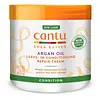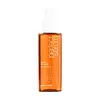What's inside
What's inside
 Key Ingredients
Key Ingredients

No key ingredients
 Benefits
Benefits

 Concerns
Concerns

 Ingredients Side-by-side
Ingredients Side-by-side

Water
Skin ConditioningCetearyl Alcohol
EmollientCanola Oil
EmollientGlycerin
HumectantPolyquaternium-37
Parfum
MaskingPropylene Glycol Dicaprylate/Dicaprate
EmollientBehentrimonium Methosulfate
Dicetyldimonium Chloride
EmulsifyingOlea Europaea Fruit Oil
MaskingButyrospermum Parkii Butter
Skin ConditioningCapryloyl Glycerin/Sebacic Acid Copolymer
Skin ConditioningDiheptyl Succinate
EmollientPhenoxyethanol
PreservativeEthylhexylglycerin
Skin ConditioningPropylene Glycol
HumectantArgania Spinosa Kernel Oil
EmollientPolyquaternium-10
Trideceth-6
EmulsifyingC11-15-Isoalkanes
PerfumingCitric Acid
BufferingDisodium EDTA
Sodium Chloride
MaskingSodium Ferrocyanide
Limonene
PerfumingBenzyl Alcohol
PerfumingLinalool
PerfumingWater, Cetearyl Alcohol, Canola Oil, Glycerin, Polyquaternium-37, Parfum, Propylene Glycol Dicaprylate/Dicaprate, Behentrimonium Methosulfate, Dicetyldimonium Chloride, Olea Europaea Fruit Oil, Butyrospermum Parkii Butter, Capryloyl Glycerin/Sebacic Acid Copolymer, Diheptyl Succinate, Phenoxyethanol, Ethylhexylglycerin, Propylene Glycol, Argania Spinosa Kernel Oil, Polyquaternium-10, Trideceth-6, C11-15-Isoalkanes, Citric Acid, Disodium EDTA, Sodium Chloride, Sodium Ferrocyanide, Limonene, Benzyl Alcohol, Linalool
Cyclopentasiloxane
EmollientDimethiconol
EmollientC12-15 Alkyl Benzoate
AntimicrobialParfum
MaskingArgania Spinosa Kernel Oil
EmollientSimmondsia Chinensis Seed Oil
EmollientCocos Nucifera Oil
MaskingLimonene
PerfumingPrunus Armeniaca Kernel Oil
MaskingOlea Europaea Fruit Oil
MaskingSclerocarya Birrea Seed Oil
HumectantCamellia Japonica Seed Oil
EmollientCoco-Caprylate/Caprate
EmollientLinalool
PerfumingCitronellol
PerfumingCaprylic/Capric Triglyceride
MaskingGeraniol
PerfumingCapsicum Annuum Extract
MaskingBeta-Carotene
Skin ConditioningTocopherol
AntioxidantGlycolipids
Skin ConditioningCyclopentasiloxane, Dimethiconol, C12-15 Alkyl Benzoate, Parfum, Argania Spinosa Kernel Oil, Simmondsia Chinensis Seed Oil, Cocos Nucifera Oil, Limonene, Prunus Armeniaca Kernel Oil, Olea Europaea Fruit Oil, Sclerocarya Birrea Seed Oil, Camellia Japonica Seed Oil, Coco-Caprylate/Caprate, Linalool, Citronellol, Caprylic/Capric Triglyceride, Geraniol, Capsicum Annuum Extract, Beta-Carotene, Tocopherol, Glycolipids
 Reviews
Reviews

Ingredients Explained
These ingredients are found in both products.
Ingredients higher up in an ingredient list are typically present in a larger amount.
You may know this ingredient as argan oil. Argan Oil has antioxidant, hydrating, and soothing properties.
Studies have shown argan oil can help fight again radical damage from the sun. This makes it effective at preventing hyperpigmentation.
Large amounts of vitamin E found in argan oil helps the skin retain water. Argan oil also contains fatty acids such as linoleic acid, oleic acid, and palmitic acid. It is also a good source of lipids.
Another benefit of argan oil is skin-soothing. It can help reduce inflammation-related skin symptoms.
Argan Oil is effective at regulating sebum production in pores. This can make it effective at treating hormonal acne.
Traditionally, argan oil was used for its antibacterial and antifungal properties. However, argan oil contains fatty acids that may make it not fungal-acne safe.
Argan Trees are native to Morocco.
Learn more about Argania Spinosa Kernel OilLimonene is a fragrance that adds scent and taste to a formulation.
It's found in the peel oil of citrus fruits and other plants such as lavender and eucalyptus. The scent of limonene is generally described as "sweet citrus".
Limonene acts as an antioxidant, meaning it helps neutralize free radicals.
When exposed to air, oxidized limonene may sensitize the skin. Because of this, limonene is often avoided by people with sensitive skin.
The term 'fragrance' is not regulated in many countries. In many cases, it is up to the brand to define this term. For instance, many brands choose to label themselves as "fragrance-free" because they are not using synthetic fragrances. However, their products may still contain ingredients such as essential oils that are considered a fragrance.
Learn more about LimoneneLinalool is a fragrance and helps add scent to products. It's derived from common plants such as cinnamon, mint, citrus, and lavender.
Like Limonene, this ingredient oxidizes when exposed to air. Oxidized linalool can cause allergies and skin sensitivity.
This ingredient has a scent that is floral, spicy tropical, and citrus-like.
Learn more about LinaloolOlea Europaea Fruit Oil is the fixed oil obtained from the ripe fruit of the Olive. In other words - olive oil.
The primary contents of olive oil are glycerides of the fatty acids linoleic, oleic and palmitic.
Olive oil also contains antioxidants such as Vitamin E. Antioxidants may help reduce signs of aging by fighting unstable free-radical molecules. It also contains Vitamins A (retinol), D, and K.
The squalene in olive oil makes it a great emollient. Emollients help soothe and soften your skin by trapping moisture in. This makes olive oil a great skin moisturizer.
Studies show olive oil to have antibacterial and antifungal properties in low concentrations. Another study found olive oil irritated sensitive oily skin. We always recommend speaking with a professional about using this ingredient in your routine.
Due to the fatty acid content, this ingredient may not be fungal-acne safe.
Learn more about Olea Europaea Fruit OilParfum is a catch-all term for an ingredient or more that is used to give a scent to products.
Also called "fragrance", this ingredient can be a blend of hundreds of chemicals or plant oils. This means every product with "fragrance" or "parfum" in the ingredients list is a different mixture.
For instance, Habanolide is a proprietary trade name for a specific aroma chemical. When used as a fragrance ingredient in cosmetics, most aroma chemicals fall under the broad labeling category of “FRAGRANCE” or “PARFUM” according to EU and US regulations.
The term 'parfum' or 'fragrance' is not regulated in many countries. In many cases, it is up to the brand to define this term.
For instance, many brands choose to label themselves as "fragrance-free" because they are not using synthetic fragrances. However, their products may still contain ingredients such as essential oils that are considered a fragrance by INCI standards.
One example is Calendula flower extract. Calendula is an essential oil that still imparts a scent or 'fragrance'.
Depending on the blend, the ingredients in the mixture can cause allergies and sensitivities on the skin. Some ingredients that are known EU allergens include linalool and citronellol.
Parfum can also be used to mask or cover an unpleasant scent.
The bottom line is: not all fragrances/parfum/ingredients are created equally. If you are worried about fragrances, we recommend taking a closer look at an ingredient. And of course, we always recommend speaking with a professional.
Learn more about Parfum